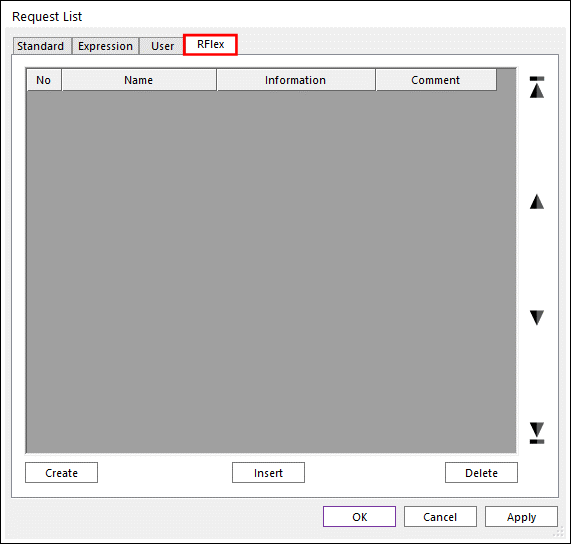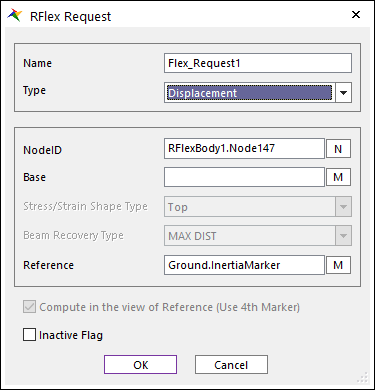
In the RFlex tab, you can define the output of displacement, velocity, acceleration and deformation of RFlex. To use this tab, click the RFlex tab in the Request List dialog box.

Figure 1 Request List dialog box [RFlex]

Figure 2 RFlex Request dialog box
•Name: Defines the name of RFlex Request.
•Type: Selects the type of RFlex Request. It has the six types that are Displacement, Velocity, Acceleration, Deformation, Stress and Strain.
•NodeID, Base and Reference: The orientation of NodeID is printed in a 313 Euler angle and is independent the reference marker. If the user doesn't select the base marker, it becomes the inertia reference frame. Also, if the user doesn't select the reference marker, the reference marker becomes the inertia reference frame.
•Note: Deformation is defined as a displacement from the undeformed node position to the current node position of NodeID with respect to the body reference frame of the RFlex body. Therefore, in the case of Deformation type, Base and Reference should be defined as the body reference frame of RFlex body. The user cannot change Base and Reference information in the case of Deformation type.
•Stress/Strain Shape Type: Selects None, Top, or Bottom. Default is Top. If the input RFlex node is connected with a shell type element and also the RFI have both Top and Bottom stress/strain shapes, then this option is refered correctly. If the RFI file has a one type of Top or Bottom, this option is not used.
•Beam Recovery Type: Selects None, C, D, E, F, MAX DIST, or MAX VMISES. If the input RFlex node is connected with a beam type element, then this option is referred correctly.
•Compute in the view of Reference (Use 4th Marker): Allows computing velocity or acceleration of selected node relative to base marker in the view of reference marker.
•Inactive Flag: Allows using the Inactive menu in the Database Window. For more information, click here.
Note
In order to calculate the stress and strain of defined output node, the stress shape and strain shape information is respectively needed. If the RFI file of the RFlex body doesn’t have the stress shape/strain shape information, the stress/strain results are always zero.